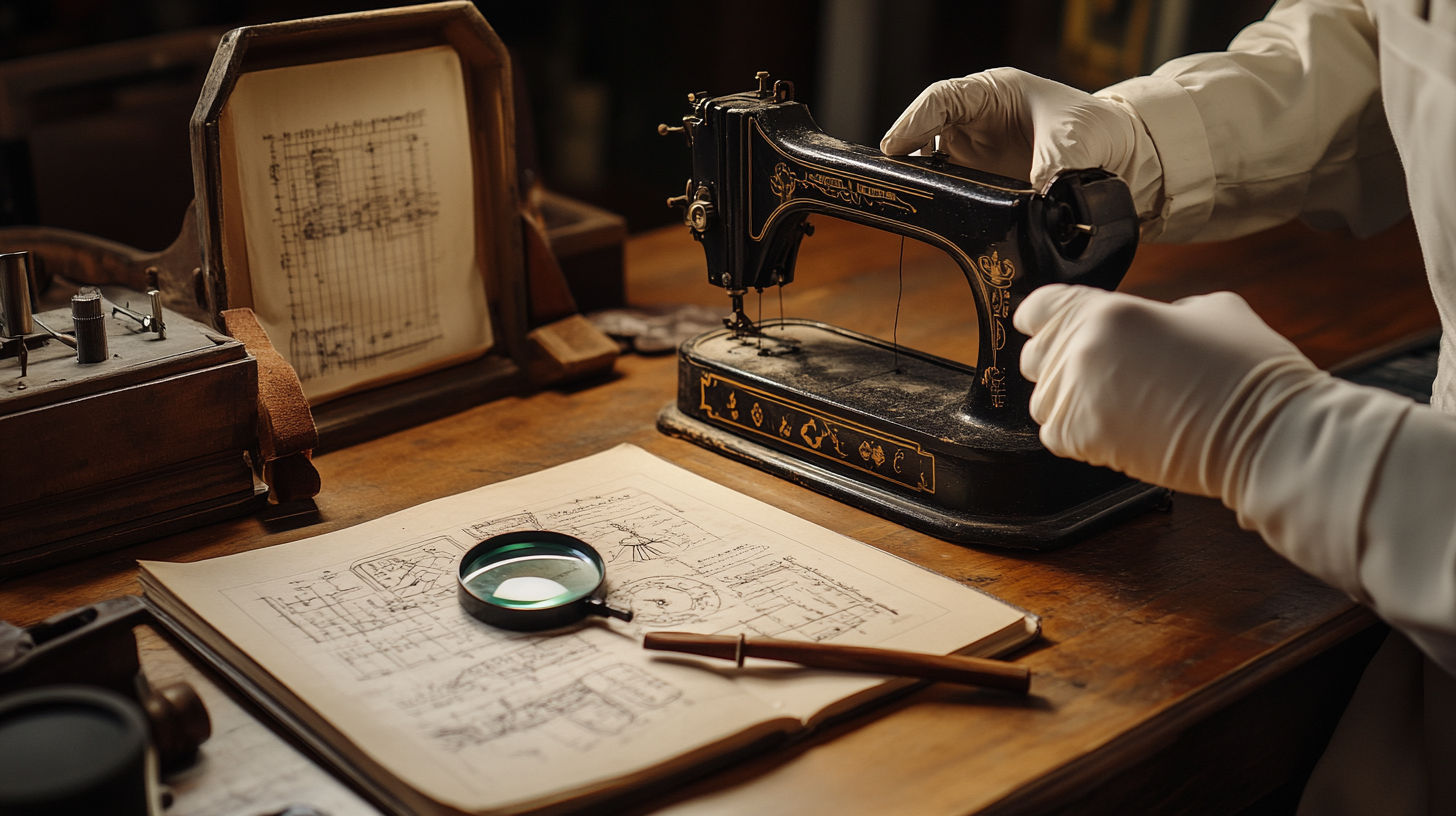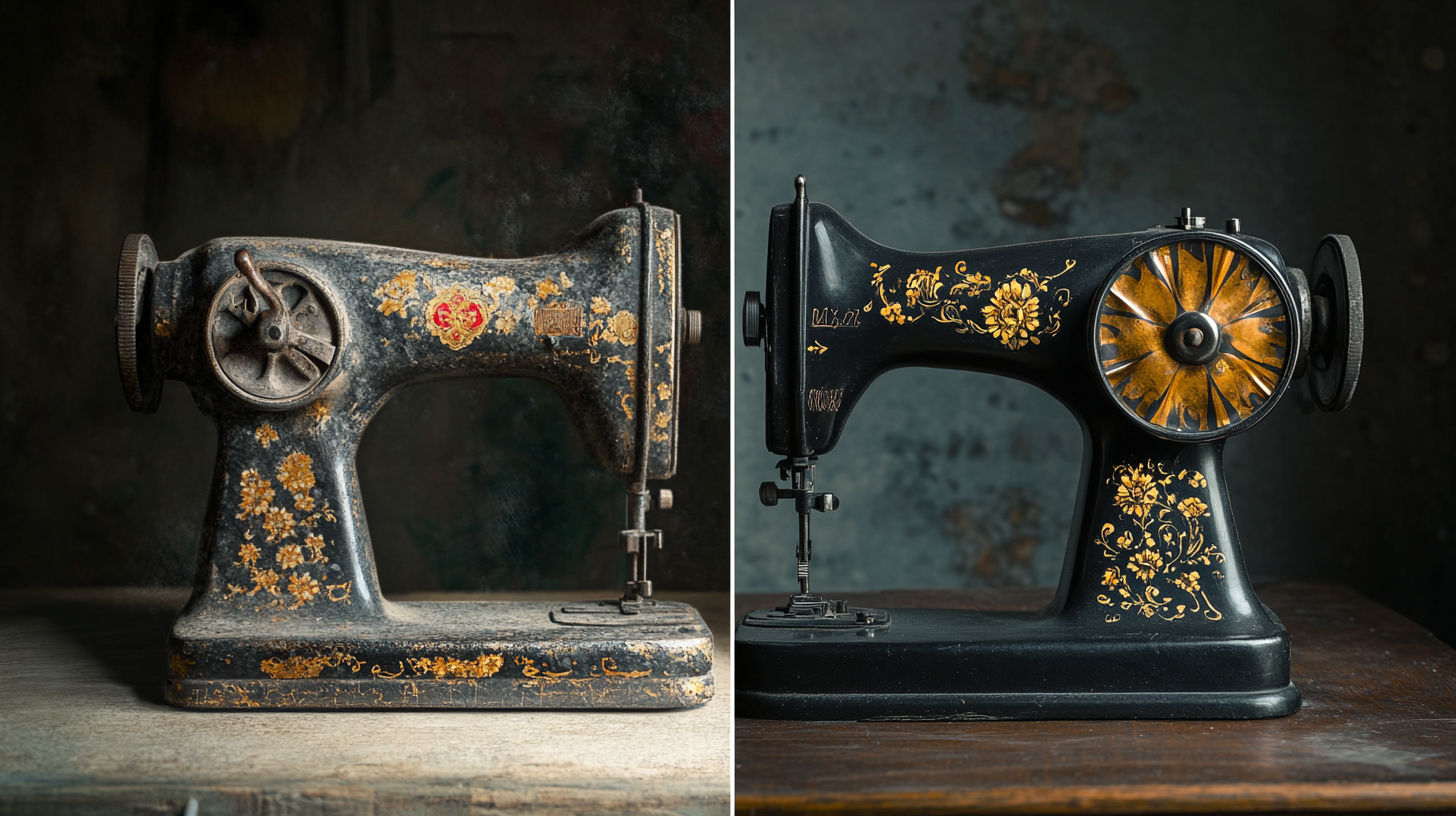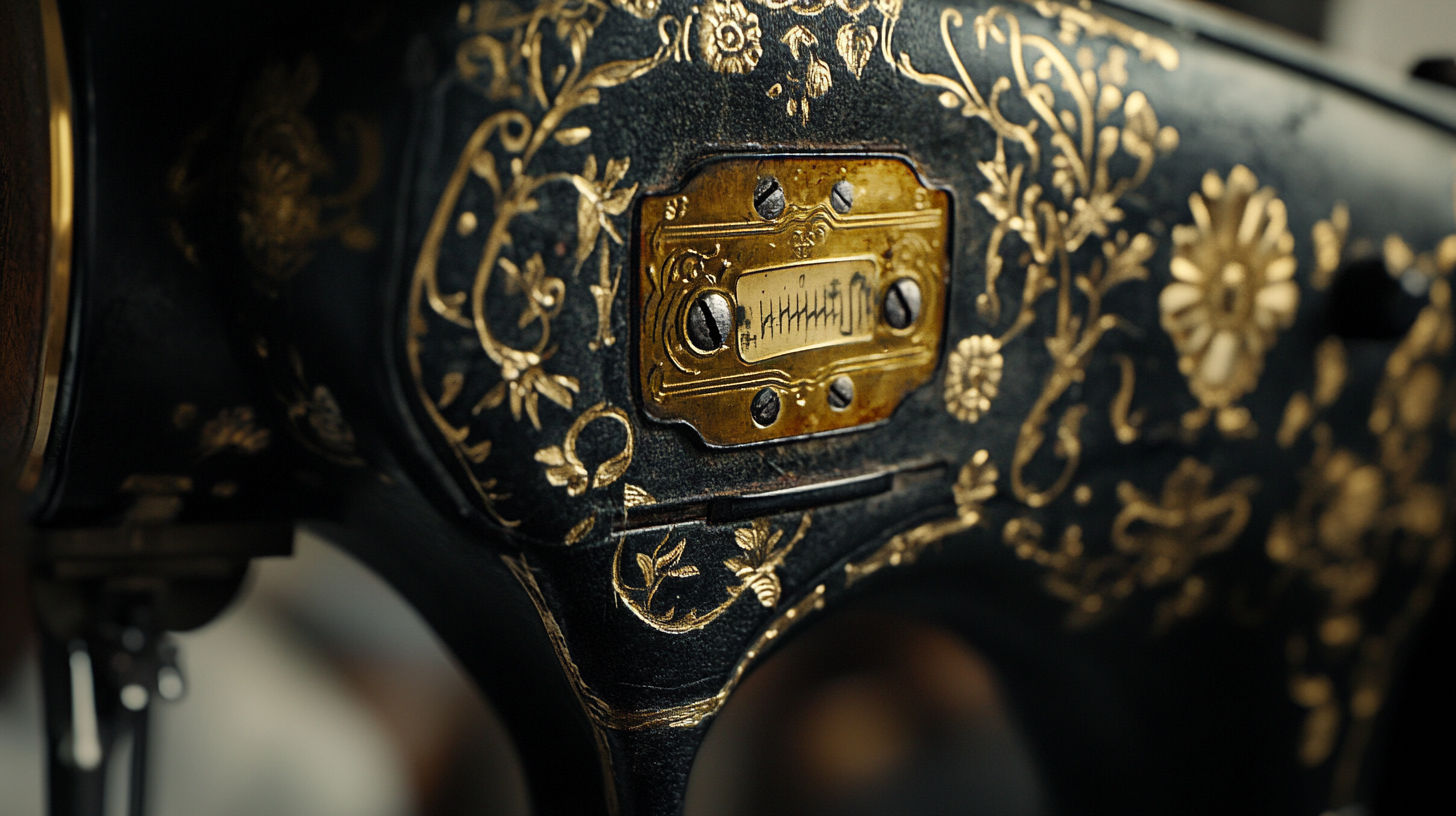Have you recently discovered a vintage sewing machine in your attic, inherited one from a relative, or spotted one at a garage sale? These charming mechanical devices often carry both historical significance and potentially substantial monetary value. Whether you’re a collector, seller, or just curious about that old Singer in your basement, understanding antique sewing machine value is essential to appreciating these remarkable pieces of craftsmanship.
In this comprehensive guide, we’ll explore what makes antique sewing machines valuable, how to identify different models, and what factors influence their worth in today’s market. From treadle-powered Singers to rare White Rotary models, we’ll help you determine if you’ve got a basic vintage model or a genuine collector’s treasure.
Table of Contents
- What Makes a Sewing Machine “Antique”?
- Key Factors That Determine Value
- Identifying Your Antique Sewing Machine
- Most Valuable Antique Sewing Machine Brands
- Price Ranges for Antique Sewing Machines
- Where to Sell Your Antique Sewing Machine
- Tips for Caring for Vintage Machines
- Common Questions
- External Resources
What Makes a Sewing Machine 'Antique'?
Generally, sewing machines fall into several categories based on their age:
- Antique: Generally considered to be machines manufactured before 1900, often treadle or hand-crank operated
- Vintage: Typically refers to machines made between 1900 and 1970
- Collectible: Newer machines (post-1970) with unique features or limited production
- Modern: Contemporary machines with electronic or computerized components
The distinction matters because true antiques—especially those over 100 years old—often command higher prices among collectors. However, certain vintage machines from the early-to-mid 20th century can also be quite valuable if they possess unique characteristics or historical significance.
Beginning in the 1980s, sewing machines started incorporating circuit boards and computerized features, marking the end of what most collectors consider the “vintage” era. These newer machines generally hold less collector value, though they may still be practical for sewing enthusiasts.
Antique Sewing Machine Market Statistics
Key Factors That Determine Value
Age and Rarity
Age alone doesn’t determine value—some extremely old machines are quite common and therefore less valuable than rarer models from later periods. However, machines manufactured before 1900, especially those from the 1850s-1870s when sewing machines were still evolving, can be highly prized by collectors.
Condition
The condition of an antique sewing machine significantly impacts its value. Collectors and enthusiasts prefer machines that:
- Have their original finish intact
- Feature clear, visible decals and decorative elements
- Include original components and attachments
- Are mechanically functional or can be restored to working condition
Condition Assessment Checklist
Check all items that apply to your sewing machine to estimate its condition quality
- Original finish with minimal wear
- Decals and decorative elements intact
- All mechanical parts present and functional
- Original cabinet or case in good condition
- Original manual and accessories included
- No rust or major damage to metal components
- Machine runs smoothly (if motorized)
Completeness
Machines that come with their original cabinet, case, accessories, attachments, and instruction manual generally command higher prices. The presence of original bobbins, presser feet, oil cans, and other accessories can significantly increase value.
Brand and Model
Some brands and specific models are more sought after than others. Singer, especially certain models like the Featherweight 221, tends to be among the most valuable. However, rare models from manufacturers like Wheeler & Wilson, Willcox & Gibbs, or White can sometimes be worth even more to the right collector.
Historical Significance
Machines with connections to historical events, technological advancements, or cultural significance can be particularly valuable. For example, the first models of a revolutionary design or machines used in notable historical contexts often fetch premium prices.

Identifying Your Antique Sewing Machine
Locating the Serial Number
The first step in identification is finding the serial number, which varies in location depending on the manufacturer:
- Singer machines: Look for the serial number on the front of the machine, on the bed plate, or occasionally on the back or bottom
- White machines: Usually located on the bed plate or front of the machine
- Wheeler & Wilson machines: Often found on the slide plate or arm
- Other brands: Check the front base, bed plate, or beneath the machine
Using the Serial Number to Date Your Machine
Once you have the serial number, you can use it to determine when your machine was manufactured:
- For Singer machines, visit the Singer website or use the International Sewing Machine Collectors’ Society (ISMACS) database
- For other brands, consult collector websites or reference books specific to that manufacturer
- Many antique dealers and sewing machine repair shops can also help with identification
Identifying Features and Characteristics
Beyond the serial number, certain design elements can help identify your machine:
- Treadle vs. hand-crank: Earlier machines typically used these manual power methods
- Fiddle base: A violin-shaped base was common on early models
- Decal patterns: Specific decorative patterns can identify both era and model
- Bobbin system: Different types (round bobbin, long bobbin, etc.) can indicate manufacturer and era
Evolution of Sewing Machine Design
- 1850s-1860s
Early Commercial Machines
The first commercially successful machines featured treadle operation, ornate iron work, and basic stitch capabilities. These early machines often had fiddle-shaped bases and transverse shuttles. - 1870s-1890s
Golden Age of Decoration
This period saw elaborate "Victorian" styling with gold decals, mother-of-pearl inlays, and ornate wooden cabinets. These highly decorative machines are particularly sought after by collectors. - 1900s-1920s
Early Electric Models
The introduction of electric motors transformed sewing machines. Early electric models that retain their original motors in working condition can be quite valuable. - 1930s-1950s
Portable Revolution
Lightweight portable machines like the Singer Featherweight gained popularity. These compact machines continue to be among the most valuable vintage models due to their practicality and design.
Most Valuable Antique Sewing Machine Brands
Singer
As the most prolific sewing machine manufacturer, Singer produced millions of machines—but certain models stand out for their value:
- Singer Featherweight 221: These portable machines from the 1930s-1960s often sell for $400-$1,500 depending on condition and accessories
- Singer 301: The successor to the Featherweight, valued at $200-$600
- Singer Red Eye Models: Distinctive machines with “red eye” decals from the early 1900s, worth $200-$500
- Singer Turtleback: Rare models from the 1870s-1880s with a distinctive shape, potentially worth $1,000+
Willcox & Gibbs
These distinctive chain-stitch machines with their unique curved shape are highly sought after:
- Early models from the 1870s often sell for $300-$900
- Rare variations can exceed $1,000 for serious collectors
Wheeler & Wilson
One of Singer’s main early competitors, these machines are relatively rare and attractive to collectors:
- Models from the 1870s-1880s typically value between $300-$800
- The Wheeler & Wilson No. 8 is particularly sought after
White
Known for quality and innovation, certain White models command good prices:
- White Family Rotary models from the early 1900s: $200-$450
- White Peerless models: $250-$500 depending on condition
Price Ranges for Antique Sewing Machines
Price Ranges for Antique Sewing Machines
Current market values as of 2023
</tbody>
</table>
It’s important to note that special circumstances can dramatically affect value. Machines with provenance (documented history of ownership), original accessories, or exceptional preservation may command prices well above these ranges.
What NOT to Expect
Despite what some sellers hope for, most common vintage machines aren’t worth thousands of dollars. According to collectors and dealers, approximately 95% of second-hand sewing machines sell for between $25 and a few hundred dollars. Only rare, exceptional, or historically significant machines command premium prices.
As one Reddit user from r/vintagesewing explains: “95% of second hand sewing machines are indeed not worth much, most between 25 and max a couple of hundred USDs for modern or famous models.”
Where to Sell Your Antique Sewing Machine
Online Marketplaces
- eBay: The largest marketplace for antique sewing machines, providing access to a global audience of collectors
- Etsy: Appeals to vintage enthusiasts and collectors
- Facebook Marketplace: Good for local sales without shipping concerns
- Specialized forums: Websites dedicated to sewing machine collectors can connect you with serious buyers
Physical Locations
- Antique shops: Some specialize in vintage tools and machinery
- Auction houses: For particularly valuable or rare machines
- Sewing machine repair shops: Often purchase machines for parts or restoration
- Collector meetups: Events where enthusiasts gather to buy, sell, and trade
Getting the Best Price
To maximize your selling price:
- Clean and polish your machine without damaging original finishes
- Gather all accessories, attachments, and documentation
- Research comparable sales to set a realistic price
- Provide detailed photos highlighting condition and special features
- Be prepared to answer questions about functionality and history

Tips for Caring for Vintage Machines
Cleaning and Maintenance
- Use soft cloths and appropriate cleaners for different materials (metal, wood, etc.)
- Never use harsh chemicals or abrasives that could damage original finishes
- Apply sewing machine oil to moving parts (sparingly)
- Keep machines away from extreme temperature and humidity fluctuations
Restoration Considerations
The question of restoration is complex in the antique world. Generally:
- Light cleaning and careful maintenance is almost always appropriate
- Mechanical restoration to working condition can increase value for machines intended for use
- Cosmetic restoration like repainting or replacing decals is controversial and can actually decrease value for serious collectors
- Cabinet restoration should be approached cautiously, preserving original finishes when possible
Storage Recommendations
- Cover machines to protect from dust
- Store in climate-controlled environments when possible
- Keep original cases, cabinets, and documentation together with the machine
- Periodically oil moving parts even in storage
Common Questions About Antique Sewing Machine Values
How do I find the value of my old sewing machine?
To determine the value of your old sewing machine:
- Find the serial number (typically on the base or body of the machine)
- Research the make, model, and age using online resources such as the Singer Help Center or ISMACS International database
- Assess the condition, completeness, and functionality
- Compare with similar machines that have recently sold on eBay, 1stDibs, or other marketplaces
- For a professional opinion, consult an antique dealer or appraiser who specializes in vintage sewing machines
Remember that values vary considerably based on condition, rarity, and current market demand.
What is the most valuable antique sewing machine?
The most valuable antique sewing machines tend to be extremely rare models or those with significant historical importance. Some examples include:
- The earliest Singer machines from the 1850s
- Rare prototypes or limited production models
- Machines with documented historical significance
- Exceptionally preserved examples with original accessories
A 19th-century Singer that belonged to Queen Victoria sold at auction for nearly $20,000, while extremely rare models like the Singer "Turtle Back" from the 1870s can sell for several thousand dollars when in pristine condition.
The Singer Featherweight 221, while not the most valuable in absolute terms, is consistently sought after, with prices ranging from $400-$1,500 depending on condition, color variant, and accessories.
Are old Singer treadle sewing machines worth anything?
Yes, Singer treadle sewing machines do have value, though they're generally not as valuable as some collectors hope. Their worth typically ranges from:
- $100-$250 for common models in average condition
- $250-$400 for machines with intact original cabinets in good condition
- $400-$600+ for rare models or those in exceptional condition with all accessories
The value is affected by several factors:
- Cabinet condition (quality of wood, original finish)
- Completeness of the treadle mechanism
- Functionality of the machine
- Preservation of original decals and finish
- Presence of original accessories and attachments
While some online listings ask for $1,000+, actual selling prices for typical treadle machines are usually more modest. The most common treadle models produced in large quantities between 1890-1920 are readily available, which limits their value.
What can I do with an old antique sewing machine?
There are several options for what to do with an old antique sewing machine:
Sell it: Online marketplaces like eBay, Etsy, Facebook Marketplace, or to local antique dealers
Restore and use it: Many vintage machines, particularly cast iron models, are built to last and can still be used for sewing after proper servicing
Donate it:
- Museums or historical societies (for rare or historically significant machines)
- Sewing programs or schools
- Repair shops that might use them for parts
Repurpose it: Creative repurposing as furniture or decor (though collectors generally prefer machines to remain intact)
Display it: Keep it as a decorative piece and conversation starter in your home
If your machine is broken but potentially valuable, consider selling it to a restorer who specializes in vintage sewing machines rather than discarding it.
How can I tell if my Singer sewing machine is valuable?
To determine if your Singer sewing machine is valuable:
Identify the model and age: Find the serial number (typically on the base of the machine) and use Singer’s online database or the ISMACS website to determine when it was manufactured
Look for valuable models: Some Singer models are consistently worth more, including:
- Featherweight 221 (especially rare colors like white or tan)
- Early models with the "Sphinx" decals (1890s)
- Models with rare decal patterns like "Red Eye" or "Tiffany"
- Singer 301, 401, 500 series (Rocketeer) in excellent condition
- Pre-1900 models, especially those with unusual features
Assess condition factors that increase value:
- Original finish and clear decals
- Complete set of original accessories
- Original manual and case
- Working mechanical condition
- No significant rust or damage
While most common Singer machines from the mid-20th century are worth $50-$200, rare models in excellent condition can sell for hundreds or even thousands of dollars to collectors.
External Resources for Antique Sewing Machine Research
International Sewing Machine Collectors' Society (ISMACS)
Offers extensive resources for identifying and valuing antique sewing machines, including a database of serial numbers and manufacturing dates.
Singer Official Value Information
Singer's official guide to determining the value of vintage Singer sewing machines, including information on identifying different models.
Vintage Sewing Machine eBay Listings
Browse current and completed sales of antique sewing machines to gauge current market values and demand.
r/vintagesewing Subreddit
A community of vintage sewing machine enthusiasts sharing knowledge, restoration tips, and valuation advice.
Patented Antiques Sewing Machine Information
Detailed information about antique sewing machine values from an established dealer, including which models are most collectible.
1stDibs Antique Sewing Machine Marketplace
High-end antique marketplace featuring premium examples of collectible sewing machines from reputable dealers.
Conclusion: Are Antique Sewing Machines Worth the Investment?
Antique sewing machines represent an interesting intersection of history, craftsmanship, and practicality. While not all old machines are valuable treasures, certain models—particularly those that are rare, in excellent condition, or historically significant—can be worth hundreds or even thousands of dollars to the right buyer.
For most people who discover an old Singer or other brand in their attic or at an estate sale, the machine will likely be worth between $50 and $500 depending on the model and condition. The most common treadle machines typically sell for $100-$400, while exceptional or rare models can command much higher prices.
Whether you’re looking to sell a family heirloom, start collecting, or simply appreciate the history of these mechanical marvels, understanding what influences their value helps you make informed decisions. Remember that beyond monetary worth, these machines tell the story of domestic life and technological innovation across generations—a value that transcends any price tag.
If you have a sewing machine you’d like to learn more about, consider consulting with a professional appraiser who specializes in antique tools and machinery, or reaching out to collector communities who can help identify rare or valuable features.
Get a Professional Appraisal
Unsure about your item’s value? Our certified experts provide fast, written appraisals you can trust.
- Expert report with photos and comps
- Fast turnaround
- Fixed, upfront pricing
No obligation. Secure upload.
| Category | Price | Notes |
|---|---|---|
| Common Treadle Machines (1890-1910) | $100-$400 | Good condition with cabinet |
| Singer Featherweight 221 | $400-$1,500 | Based on condition and accessories |
| Rare Pre-1870 Models | $500-$2,500+ | Exceptional examples with provenance |
| Common Electric Models (1930s-1950s) | $50-$200 | Working condition |
| Singer 301, 401, 500 series | $200-$600 | With accessories and original case |
| Rare Manufacturer Models (Willcox & Gibbs, etc.) | $300-$1,000+ | Excellent condition with original features |




